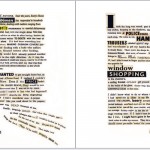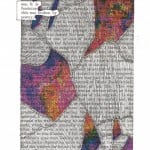The inspiration for this post comes from this blog from @Missjlud. I loved the idea of Blackout poetry and was already considering how to use it my own lessons when I was asked to create a scheme of work for Expressive Arts, which we do as an additional GCSE in year 11. I jumped at this opportunity because I love teaching the subject and began to think of how we could use this. (Expressive Arts covers art, creative writing, music, drama, dance- students must integrate two of these for coursework.)
I took the step of combining Art and English departmental meetings in order to tap in to the wide range of ideas. Both departments teach Expressive Arts and I thought it would be a really positive experience to join our brains, especially when it is relatively new to all of us. (I have already committed to team-teaching Expressive Arts with an Art NQT which I know will I be mutually beneficial.) The discussions were even more productive than I had hoped and I was introduced to a number of writers/ artists that I would never have discovered without the collaboration. The theme of remixing and reimagining emerged- taking things out of context, breaking things and reconstructing them.
Here then are some of the ideas:
I am a big fan of Dave Gorman. I like the way that he embraces chance in a number of his projects e.g. The Googlewhack Adventure. On his radio show, Gorman often reads his ‘found poetry’. Usually this is constructed from web comments from articles on ‘controversial’ subjects as in this example below about the Sugababes:
John Hollander: ‘anyone may “find” a text; the poet is he who names it, “Text”‘. While students may well create something good enough from randomly selecting the lines for their poem, I would recommend they collect an excess of lines and then refine what they have. Here are some ideas below:
Make a poem from the school planner.
Use YouTube comments/ web comments.
Make a poem from Twitter.
Swap exercise books and create found poetry from those.
Write down what you hear in the classroom.
Watch a clip from a film and write down dialogue as a poem.
Flick randomly through a dictionary/ book.
Use the random article feature on Wikipedia.
Another idea is book spine poetry, although it may test the patience of your librarian:
 I followed the trail of Blackout poetry to Austin Kleon. His site has examples of his work. For Expressive Arts, we need to study practitioners, so we will read his biography…then turn it into a blackout poem!
I followed the trail of Blackout poetry to Austin Kleon. His site has examples of his work. For Expressive Arts, we need to study practitioners, so we will read his biography…then turn it into a blackout poem!
I also purchased ‘A Humument’ by Tom Phillips, as recommended by one of my Art colleagues. He is an artist who bought a 3 pence Victorian Novel and turned every page into a piece of art. There is a slideshow here. 30 unique versions of the same page would make a fantastic classroom display.
 I was also introduced to Graham Rawle, who wrote an entire novel from cuttings of ‘Woman’s World’ magazine. Although it may seem like writing a ransom note, students can create text from cutting up magazines, newspapers or even old textbooks?
I was also introduced to Graham Rawle, who wrote an entire novel from cuttings of ‘Woman’s World’ magazine. Although it may seem like writing a ransom note, students can create text from cutting up magazines, newspapers or even old textbooks?
 And Keira Rathbone, who creates images using a typewriter.
And Keira Rathbone, who creates images using a typewriter.
Here are some further ideas on how remixing could be used in an English lesson:
Genre swap- explore the stylistic conventions of a text by converting it into a different genre.
Reconstructing texts- my colleague Elaine begins many poetry lessons by cutting up the poems and asking students to reconstruct them. She can add more than one to help students compare the differences or even just insert one line from another poem.
Create a ‘madlib’ from a well-known text e.g. The Raven and analyse the change in tone/ meaning.
Alphabetise your text and ask students to reconstruct it, like this version of Visiting Hour by Norman MacCaig. They can also use this as a way to analyse patterns of language.





[…] The Goldfish Bowl » Remixing texts […]
[…] The Goldfish Bowl – Reflections on teaching and learning. […]
[…] The Goldfish Bowl » Remixing texts […]